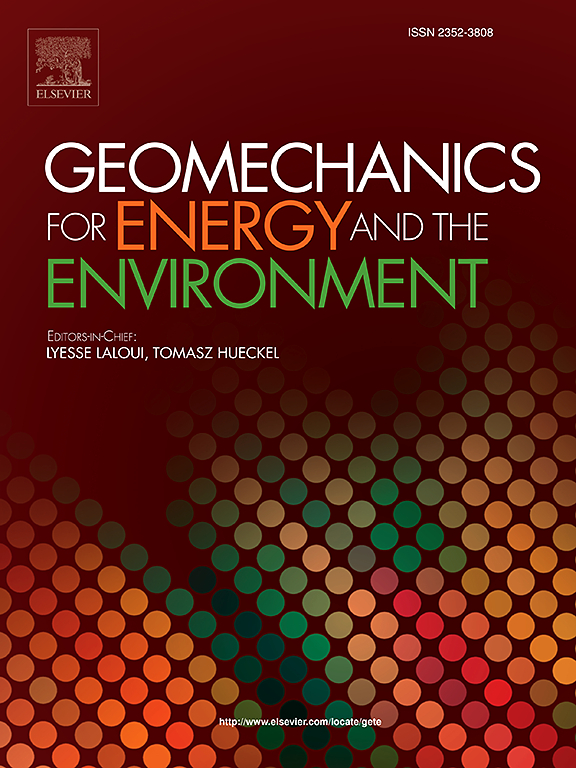机械强度对膨润土气体运移的影响:从实验室到现场的数值分析
IF 3.3
2区 工程技术
Q3 ENERGY & FUELS
引用次数: 0
摘要
了解深层地质储存库中的气体运动现象对于评估处置系统的长期稳定性至关重要。气体在膨润土中的主要输运机制是膨胀控制流动,这与一般多孔介质中的气体流动不同。这种流动的特征是气体在相对较高的气体压力条件下通过微裂纹运动,并且由于这些微裂纹的产生和扩展,介质的固有渗透率、入气压力和机械强度发生了变化。因此,传统的两相流建模技术无法模拟膨胀控制流。本研究将模拟材料降解及其固有渗透率变化的损伤模型与经典的两相流模型相结合,构建了H2MD (two-phase hydraulic-mechanical-damage)数值模型。此外,还对数值模型进行了一维实验室注气试验,并对缓冲液中的气体流动机制进行了测试,并对气体运动现象损伤模型中的关键因素抗拉强度进行了敏感性分析。在验证研究中,所提出的模型成功地模拟了试验中观察到的关键特征:应力和压力的快速增加趋势、损伤引起的固有渗透率变化以及由此产生的流量。此外,通过现场试验模拟,分析了非均质性对各材料和材料间界面强度特性的影响,并检验了该模型在上尺度分析中的适用性。非均质性效应的研究证实,结合界面强度特性能较好地模拟实际试验中观察到的气体流动路径。然而,该模型高估了气体突破前的气体流动,低估了缓冲区内受损区域的演变。因此,需要进一步研究相对渗透率和力学本构模型,以提高现有模型的可靠性。本文章由计算机程序翻译,如有差异,请以英文原文为准。
Influence of mechanical strength on gas migration through bentonite: Numerical analysis from laboratory to field scale
Understanding the gas movement phenomenon within the deep geological repository is essential for assessing the disposal system’s long-term stability. The primary gas transport mechanism through the bentonite is dilatancy-controlled flow, which differs from gas flow in general porous media. This flow is characterized by gas movement through microcracks created under relatively high gas pressure conditions, and the intrinsic permeability, air-entry pressure, and mechanical strength of the medium change due to the generation and propagation of these microcracks. Therefore, dilatancy-controlled flow cannot be simulated using the classical two-phase flow modeling technique. This study constructed the HMD (two-phase hydraulic-mechanical-damage) numerical model by combining a damage model to simulate material degradation and the resulting change in intrinsic permeability with a classical two-phase flow model. In addition, the numerical model was tested against a 1D laboratory gas injection test investing gas flow mechanisms in the buffer, and a sensitivity analysis was performed on tensile strength, a key factor in the damage model for gas movement phenomenon. In the validation study, the proposed model successfully simulated the key features observed in the test: rapid stress and pressure increase trends, changes in intrinsic permeability due to damage, and the resulting flow rate. In addition, the effect of heterogeneity on the strength characteristics of each material and interfaces between materials was analyzed through field-scale test simulations, and the applicability of the model to upscaling analysis was examined. The study of heterogeneity effects confirmed that incorporating the strength characteristics of interfaces accurately simulates the gas flow path observed in actual tests. However, the model overestimated the gas flow before the gas breakthrough and underestimated the evolution of the damaged area within the buffer. Therefore, additional research on relative permeability and mechanical constitutive models is needed to improve the reliability of the current model.
求助全文
通过发布文献求助,成功后即可免费获取论文全文。
去求助
来源期刊

Geomechanics for Energy and the Environment
Earth and Planetary Sciences-Geotechnical Engineering and Engineering Geology
CiteScore
5.90
自引率
11.80%
发文量
87
期刊介绍:
The aim of the Journal is to publish research results of the highest quality and of lasting importance on the subject of geomechanics, with the focus on applications to geological energy production and storage, and the interaction of soils and rocks with the natural and engineered environment. Special attention is given to concepts and developments of new energy geotechnologies that comprise intrinsic mechanisms protecting the environment against a potential engineering induced damage, hence warranting sustainable usage of energy resources.
The scope of the journal is broad, including fundamental concepts in geomechanics and mechanics of porous media, the experiments and analysis of novel phenomena and applications. Of special interest are issues resulting from coupling of particular physics, chemistry and biology of external forcings, as well as of pore fluid/gas and minerals to the solid mechanics of the medium skeleton and pore fluid mechanics. The multi-scale and inter-scale interactions between the phenomena and the behavior representations are also of particular interest. Contributions to general theoretical approach to these issues, but of potential reference to geomechanics in its context of energy and the environment are also most welcome.
 求助内容:
求助内容: 应助结果提醒方式:
应助结果提醒方式:


